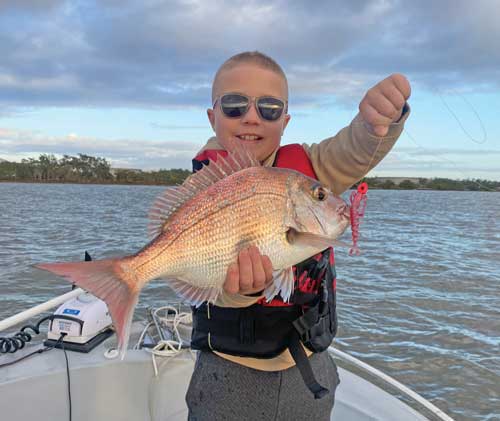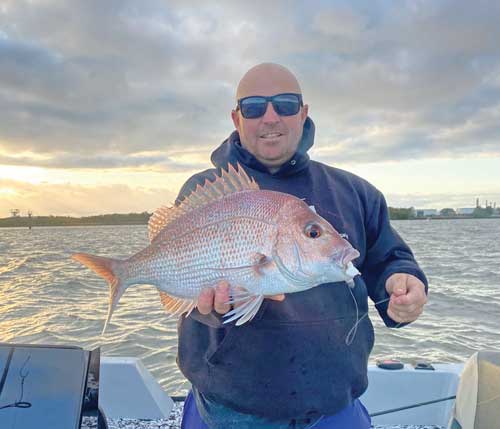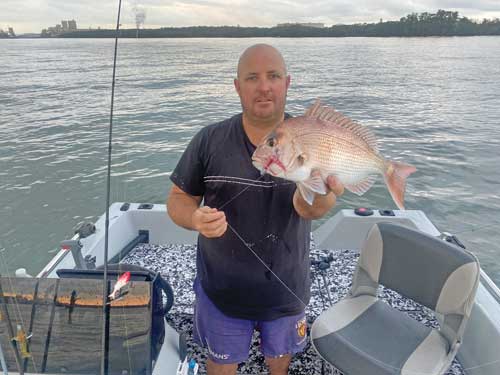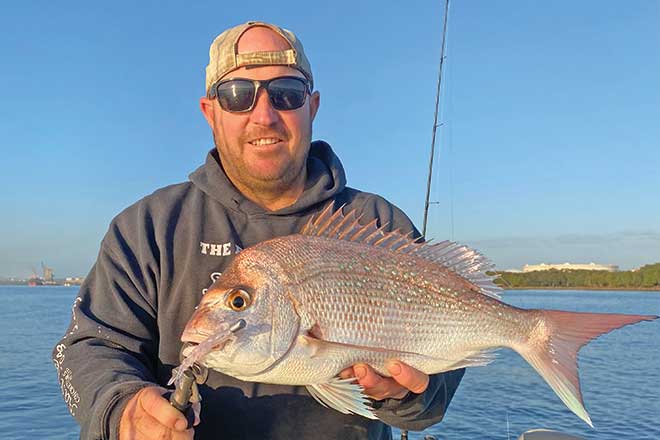My favourite fish to target in December are snapper.
The Brisbane River can turn on some excellent snapper fishing in this month and they’re a stack of fun to catch on lures.
While I spend a bit of time targeting them on bait as well, I’ll concentrate on lures for now and take a look at bait fishing in a future article.
The action has been a bit hit and miss leading up to November but they should start to turn up in better numbers.
The two things to consider when looking for snapper are structure and bait.
If you find both, you’re in with a good chance of connecting to a Brissie River snapper.

The fish in the river average about 40-50cm, with plenty of better ones in the 60-65cm range regularly turning up.
There are bigger fish in there, however they can be very hard to keep out of structure when hooked.
Different elements to look for in the river are rock walls, rock bars, pylons, channel markers and steep drop-offs.
All of these attract baitfish, so it’s a matter of sounding around until you locate the fish or bait.
Most of the snapper schools I come across in the river are fairly small, consisting of two-10 fish.
Though once located, they tend to bite when a lure is presented in front of them.
They’re a very aggressive fish and will often eat the plastic as it’s sinking in front of them and before it hits the bottom.
The strike can nearly rip the rod from your hands if you’re not ready for it.
Usually I find they eat the lure while they’re on the move and keep going after eating it.
They can pull some serious line on the first run, and they always fight all the way to the boat.

A 60cm fish can be a real handful on lighter gear. When they are hooked close to rough structure, the battle can be over in seconds.
In areas such as this, it’s a bit like mangrove jack fishing. Leaders need to be kept as light as possible to get the bites.
Snapper can be very leader shy, particularly in cleaner water. I’ll go as low as 12lb when the bites are hard to come by but prefer to use 20lb, and I’ll never go above 20 because it reduces the number of bites you get.
Jig head selection depends on the depth of water you’re fishing. I generally alternate between a 3/8oz and 1/2oz head.
The deeper water around the wharves at the mouth of the river needs a 1/2oz head to get to the bottom, but the fish will sit mid-water when there’s bait in the area.
A 1/4oz or 3/8oz head is a better option in this situation as it will sink slower, so the fish will have time to eat it.
The current can run hard in some areas in the Brisbane River.
Snapper will still bite in very strong current but it’s harder to get a lure in front of them.

I’m not a fan of when the tide has completely stopped.
I find snapper much harder to catch and a lot of the smaller annoying fish such as moses perch and pike are more active.
If I had the choice, the last two and first two hours of the tide are my favourite times.
Though occasionally, we don’t get to pick the perfect times, so it’s worth getting out there and trying to work out a pattern for yourself.
Snapper will eat a wide range of plastics, however I don’t like anything too big for them and find the 3-4” range to be perfect.
Prawn imitations are generally my first choice for snapper in the river and there’s a stack of good prawn plastics out there.
My two favourites are the Pro Lure 92mm Clone Prawn and the Jackson 3.25 Puri Ebi.
Though the Jackson Puri Ebi is becoming my number one for snapper, and they catch plenty of other species as well.
Paddle tails around 3-4” are also a great snapper plastic and there’s a huge range of these on the market too.
Personally, I prefer a slightly slimmer plastic instead of the bulkier versions.
Curl tails also work very well on snapper, with the Berkley Gulp Nemisis 4” an excellent option.
Colours are a personal choice, however make sure you have a range of natural colours such as browns and silvers, as well as some brighter colours.
I normally start with a bright fluoro colour in the paddle tails, because I’ve had more success with them in the past, however use natural colours in the prawn and curl tail presentations.
If the bright colours aren’t working, try switching over to a more natural colour to find out what they want on the day.
We’ll continue with tips and techniques for targeting snapper in the Brisbane River next month.
 Bush 'n Beach Fishing Magazine Location reports & tips for fishing, boating, camping, kayaking, 4WDing in Queensland and Northern NSW
Bush 'n Beach Fishing Magazine Location reports & tips for fishing, boating, camping, kayaking, 4WDing in Queensland and Northern NSW









Great tips, cheers! Pick up my first snap in the river this week and got railed by another one 🙂